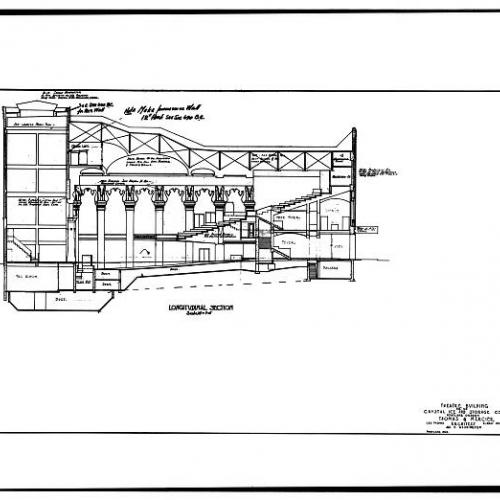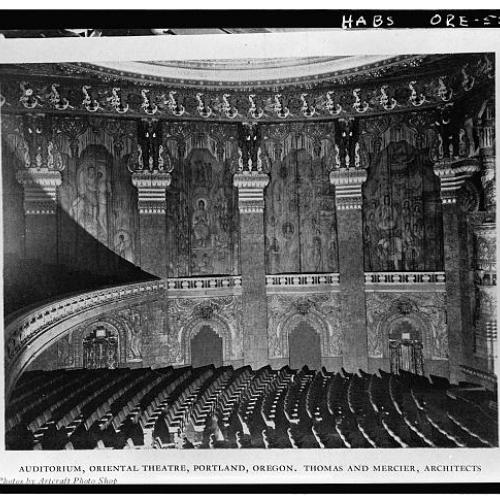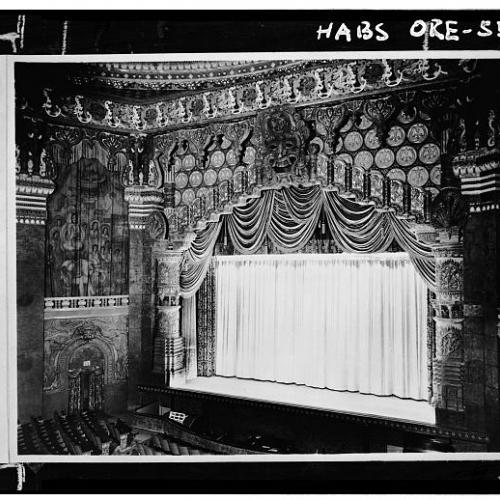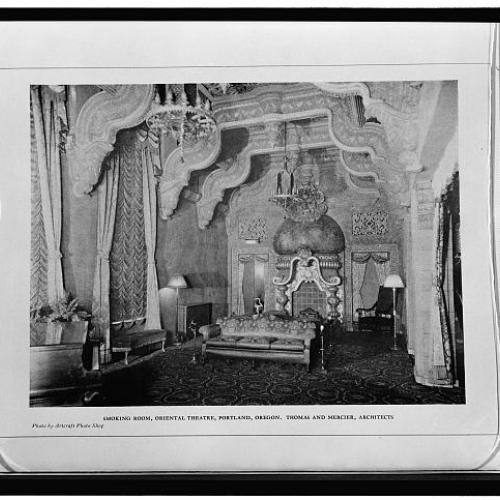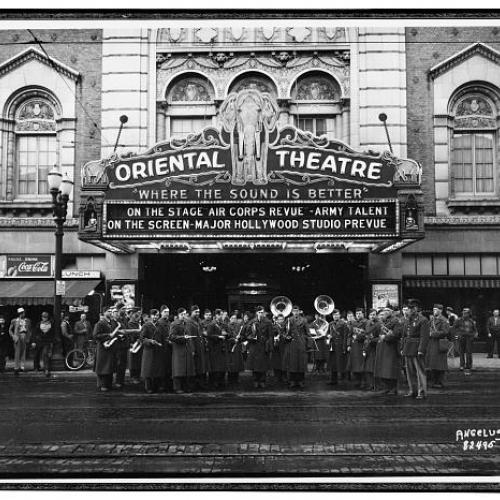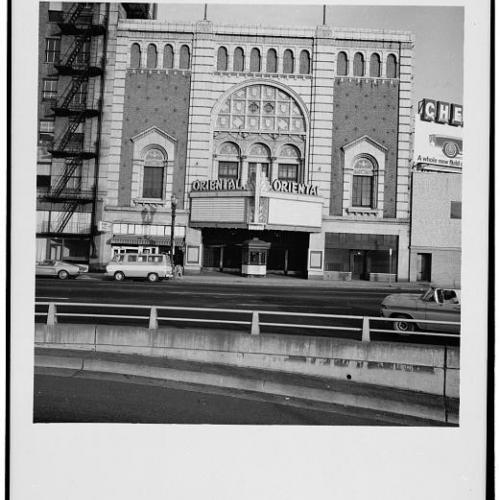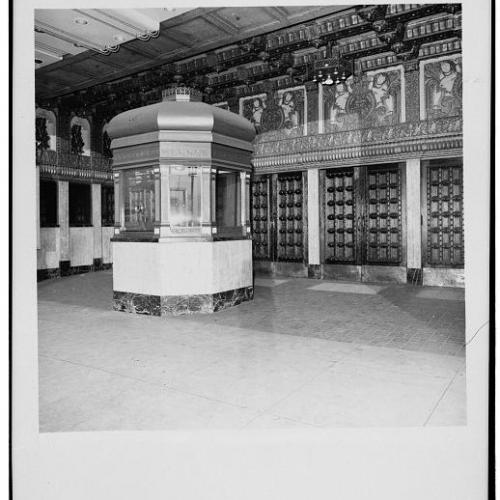One of the grandest Portland theaters during its forty plus year tenure, the Oriental Theatre was built between March and December of 1927 and finally opened on New Year’s Eve, December 31st 1927 (13)(24). Built concurrently with the adjoining Weatherly building, the theater cost somewhere between three-hundred and five-hundred thousand dollars (13) to build though the Film Daily reported its cost at six-hundred thousand (20) and the Motion Picture Record at five-hundred fifty thousand (6). Both the Weatherly building, which at twelve-stories high was considered to be one of Portland’s earliest skyscrapers (3), and the theater were owned by George W. Weatherly who commissioned their building (13).
According to tale, Walter E. Tebbetts reportedly approached Weatherly and convinced him to build the neighboring theater alongside the building (13). Tebbetts, by then, was an experienced theater manager (6) who had managed Chicago’s Italian Opera House before moving to Portland in 1909. His first Portland theater was the Empire Theatre in East Portland which he ran in 1911 and by 1926 when he sold all his assets to the West Coast Theatres company he had in one way or another had a hand in twelve different Portland movie theaters including, but not limited to, the Grand, the Alhambra, the Montavilla, the State, the Highway, and the Hollywood (5)(13). After selling all his holdings, Tebbetts and his wife traveled the world visiting both Europe and Southeast Asia (5)(13). However, Tebbetts’ history as theater owner was never far from him and it was during these travels that he got the inspiration that later manifested in the Oriental Theatre (13)(15).
Ground was broken for the building of the Weatherly building and the Oriental Theatre on March 21st, 1927 and despite predictions that the theater would be finished in the fall and opened on November 1st (2), delays in building materials resulted in the New Year’s Eve opening night (13). The theater was designed by the Thomas and Mercier firm (3) who also designed the Baghdad (5) and the Capitol theaters in Portland, the McDonald in Eugene, and the Egyptian in Coos Bay (13). The interior was designed by the sculptor Adrien Voisin who similarly designed the Orpheum in Los Angeles, El Capitan in San Francisco, and the Fox Theatre in Oakland (13). The theater was designed in a style reminiscent of Southeast Asian architecture particularly that of Hindu and Buddhist temples and Cambodia’s Angkor Wat. The lobby featured “two huge statues of Buddha” while tapestries and sculpted details reflected Oriental trends. Around the theater one could find various antiques which Tebbetts had acquired during his travels including several vases from India and French mirrors which cost two thousand each (3). Of all the ornaments featured, the most prominent were sixteen “sacred” elephants (21).
With its 2 PM December 31st opening, the Oriental Theatre was the largest theater Portland until it was surpassed in 1928 by the Portland Publix Theatre (now the Arlene Schnitzer Concert Hall) (13). Its neon sign was advertised as “the largest Neon electric sign ever built for a theatre” (6) and the red, blue and green lights were a “remarkably early example of so extensive a use of neon lighting” (13). Nevertheless, the “finest home of entertainment in this corner of the land,” (24) as the Oriental was called by the Sunday Oregonian was an experiment in a way. Prior to its opening, there had been no first-run movie theaters in Portland’s East side (6)(24) and certainly the Oriental Theatre, as a result of its size, location, and price-range, was an outlier in the context of the rest of Portland and even the Northwest.
While Portland theater owners watched with wary eyes, the Oriental opened with a flourish to a street parade accompanied by dancing, a gala festival, and an unmatched program (4). Seats were sold at $5.50 each and among other attractions were several stars that “will appear in person, among them William Boyd, Elinor Fair and Madeline Hurlock” (7). The program was varied and the main highlights were two silent films, the biblical film “Moon of Israel” (4) and the comedy “the Girl from Everywhere” which were accompanied by the orchestra of Josef Srodka, formerly of Berlin’s U.F.A. Palace and the Portland Symphony, and Glen Shelley on the Wurlitzer organ (3). The opening night was a success and the theater filled to capacity with then Mayor George L.Baker among the attendees (13).
Much like the opening night, the Oriental’s early years were successful. This success was sufficient enough that other East Side theaters began to feel the heat with S.I. Siciala, (whose Empire theater on Grand Avenue closed barely two months after the Oriental’s opening) stating that the Oriental had “cut deeply into his business” (22). This success may have been surprising to some as the price was rather steep in comparison to other Portland theaters with matinees costing 25 cents and evening shows 35 cents (3)(6)(14), yet people still came. The popularity may be in part attributed to the Oriental’s status as a “first-run” theater and each week Tebbetts introduced two new feature films with one debuting on Sundays and the other on Thursdays (3)(13). Even with two new features, Tebbetts booked so many films that he was forced to sell some FBO and De Mille films to the Orpheum (16). In general, the Oriental Theatre focused on showing films although these films were accompanied by live music and an organ. There is evidence that the theater for some time featured variety performances as the Oregonian reported in 1928 that Tebbetts was changing his policy to only including a few “brief novelties each week, mainly in singing and dancing” (1). The orchestra of Josef Srodka which had garnered so much acclaim in the early years of the Oriental would become practically obsolete with the addition of sound systems as the theater began showing films with sound in 1929 (13)(25). The theater had an excellent sound system, so much so that the Oriental was advertised on its marquee as “where the sound is better” (13).
It was not all about making a profit though and the Oriental Theatre often had charity and benefit performances which served as fundraisers for various Portland nonprofit organizations (13). A charity event was given by manager Floyd Maxwell in 1932 during which “one thousand of Portland’s unemployed” saw a showing of “So Big” (12). There was also a focus on family entertainment with a Christmas matinee for children (19) who only had to pay ten cents (3)(14) and, to make attending easier for parents, the basement was turned into a free “Kiddies’ Play Room” which was supervised and had a “sand pile, merry-go-around, swing slide and a large assortment of toys” (3)(6)(8)(17).
Manager and founder, Walter E. Tebbetts parted with the theater in 1932 (9) and it was leased to John Hamrick of the Blue Mouse Theatre between 1932 and 1935 (10)(23). Hamrick renovated the interior and reinstalled the marquee prior to re-opening the theater on May 6, 1932 (11). Despite the triumph of these early years, the size and location of the Oriental Theatre as well as the increase in television viewing led to its being sold in 1969. The contents of the theater were auctioned off on January 17th, 1970 and the building demolished in February of 1970 (13). Now where once stood the “Temple of Mirth,” (18) one of Portland’s finest entertainment establishments, one can now engage in the joyless task of parking one’s car (13).
